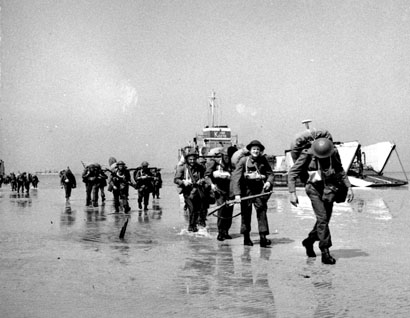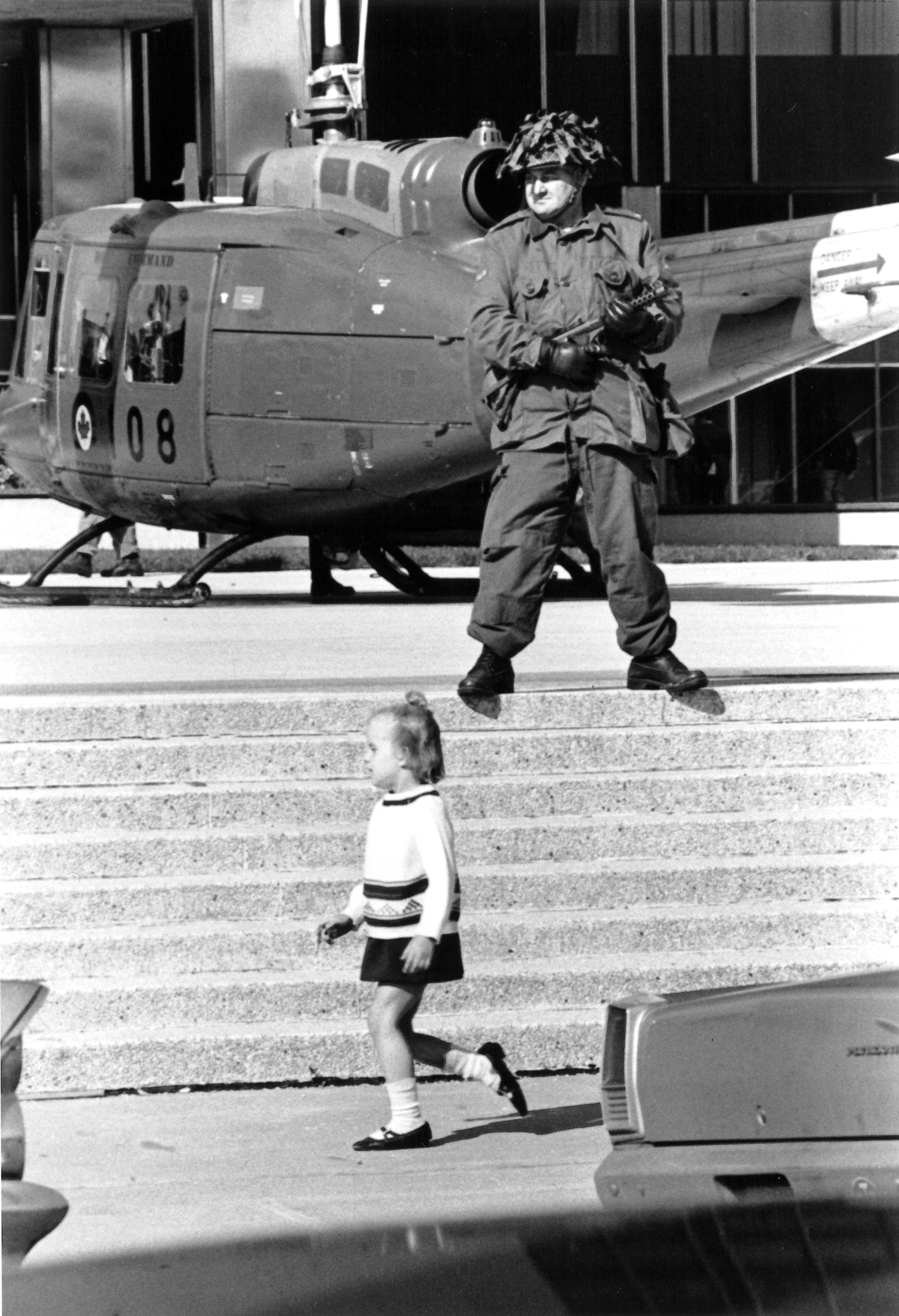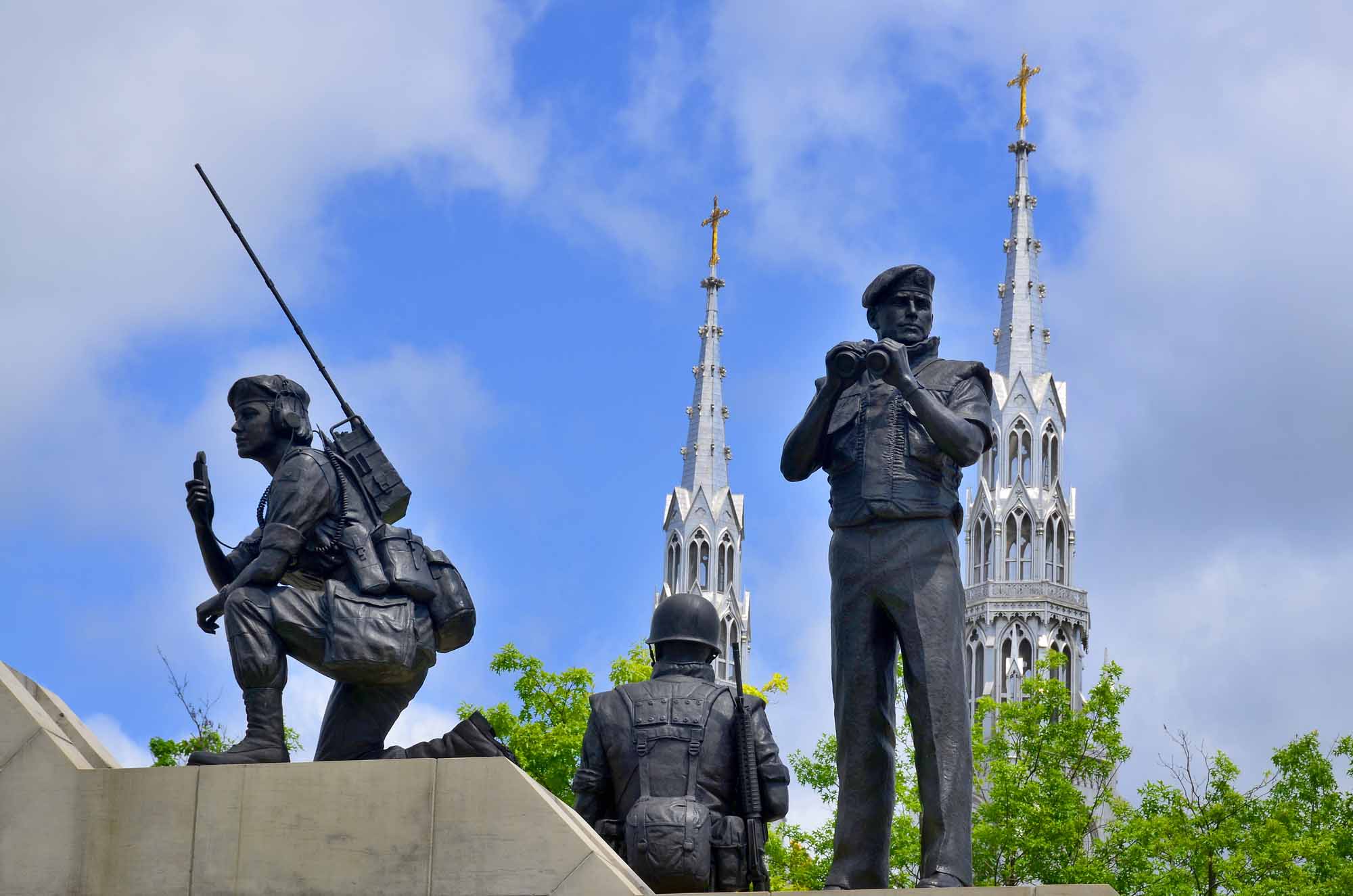Editorial
Normandy Landings: Canada on D-Day
The following article is an editorial written by The Canadian Encyclopedia staff. Editorials are not usually updated.

Enter your search term
Signing up enhances your TCE experience with the ability to save items to your personal reading list, and access the interactive map.
Create AccountEditorial
The following article is an editorial written by The Canadian Encyclopedia staff. Editorials are not usually updated.
"https://d3d0lqu00lnqvz.cloudfront.net/media/media/f2e6a0e5-8aad-4a21-86bc-c396e5d2df2e.jpg" // resources/views/front/categories/view.blade.phphttps://d3d0lqu00lnqvz.cloudfront.net/media/media/f2e6a0e5-8aad-4a21-86bc-c396e5d2df2e.jpg

Article
The 1944 Battle of Normandy — from the D-Day landings on 6 June through to the encirclement of the German army at Falaise on 21 August — was one of the pivotal events of the Second World War and the scene of some of Canada's greatest feats of arms. Canadian sailors, soldiers and airmen played a critical role in the Allied invasion of Normandy, also called Operation Overlord, beginning the bloody campaign to liberate Western Europe from Nazi occupation. Nearly 150,000 Allied troops landed or parachuted into the invasion area on D-Day, including 14,000 Canadians at Juno Beach. The Royal Canadian Navy contributed 124 vessels and 10,000 sailors and the Royal Canadian Air Force contributed 39 squadrons to the operation. Total Allied casualties on D-Day reached more than 10,000, including 1,096 Canadians, of whom 381 were killed in action. By the end of the Battle of Normandy, the Allies had suffered 209,000 casualties, including more than 18,700 Canadians. Over 5,000 Canadian soldiers died. (This is the full-length entry about D-Day and the Battle of Normandy. For a plain-language summary, please see D-Day and the Battle of Normandy (Plain-Language Summary).)
"https://d3d0lqu00lnqvz.cloudfront.net/media/media/bb05eb99-e533-4e8d-aafe-6ae70bdbf472.jpg" // resources/views/front/categories/view.blade.phphttps://d3d0lqu00lnqvz.cloudfront.net/media/media/bb05eb99-e533-4e8d-aafe-6ae70bdbf472.jpg

Article
One of the worst war crimes in Canadian history occurred in June, 1944, during the Battle of Normandy, following the D-Day landings of the Second World War. As many as 156 Canadian soldiers, taken prisoner by German forces, were executed by their captors during various incidents in the Normandy countryside.
"https://d3d0lqu00lnqvz.cloudfront.net/media/media/f6f8902f-029b-4666-8ab3-5ccd0711dda3.jpg" // resources/views/front/categories/view.blade.phphttps://d3d0lqu00lnqvz.cloudfront.net/media/media/f6f8902f-029b-4666-8ab3-5ccd0711dda3.jpg

Article
The North Shore (NB) Regiment (NS(NB)R) is a bilingual, primary reserve infantry regiment of the Canadian Army. It is part of the 5th Canadian Division, 37th Canadian Brigade Group. The regimental headquarters is located in Bathurst, New Brunswick. Regimental battle honours include Passchendaele, Ypres 1917 and Hill 70 (First World War); the Normandy Landing and the Battle of the Scheldt (Second World War).
"https://d3d0lqu00lnqvz.cloudfront.net/media/new_article_images/NorthShoreRegt/NS(NB)R Badge.jpg" // resources/views/front/categories/view.blade.phphttps://d3d0lqu00lnqvz.cloudfront.net/media/new_article_images/NorthShoreRegt/NS(NB)R Badge.jpg
R Badge.jpg)
Article
The October Crisis refers to a chain of events that took place in Quebec in the fall of 1970. The crisis was the culmination of a long series of terrorist attacks perpetrated by the Front de libération du Québec (FLQ), a militant Quebec independence movement, between 1963 and 1970. On 5 October 1970, the FLQ kidnapped British trade commissioner James Cross in Montreal. Within the next two weeks, FLQ members also kidnapped and killed Quebec Minister of Immigration and Minister of Labour Pierre Laporte. Quebec premier Robert Bourassa and Montreal mayor Jean Drapeau called for federal help to deal with the crisis. In response, Prime Minister Pierre Trudeau deployed the Armed Forces and invoked the War Measures Act — the only time it has been applied during peacetime in Canadian history.
"https://d3d0lqu00lnqvz.cloudfront.net/media/media/c8a1d56b-60f5-40b0-86e2-3ce31bc3e7b0.jpg" // resources/views/front/categories/view.blade.phphttps://d3d0lqu00lnqvz.cloudfront.net/media/media/c8a1d56b-60f5-40b0-86e2-3ce31bc3e7b0.jpg

Article
The October Crisis happened in the fall of 1970. It was sparked by the Front de liberation du Québec (FLQ). The FLQ used terrorist tactics to try and make Quebec independent from Canada. On 5 October, the FLQ kidnapped James Cross, a British trade commissioner. The FLQ also kidnapped Quebec cabinet minister Pierre Laporte. Prime Minister Pierre Trudeau invoked the War Measures Act. The Act had never been used before during peacetime. It suspended civil liberties and led to hundreds of arrests. Laporte was murdered and found on 17 October. Cross was freed on 3 December. The crisis ended on 28 December, when Laporte’s killers were captured. (This article is a plain-language summary of the October Crisis. If you are interested in reading about this topic in more depth, please see the full-length entry.)
"https://d3d0lqu00lnqvz.cloudfront.net/media/new_article_images/PA-129838-curious-children.jpg" // resources/views/front/categories/view.blade.phphttps://d3d0lqu00lnqvz.cloudfront.net/media/new_article_images/PA-129838-curious-children.jpg

Article
The Kanesatake Resistance, also known as the Oka Crisis or the Mohawk Resistance at Kanesatake, was a 78-day standoff (11 July–26 September 1990) between Kanyen'kehà:ka (Mohawk) protesters, Quebec police, the RCMP and the Canadian Army. It took place in the community of Kanesatake, near the Town of Oka, on the north shore of Montreal. Related protests and violence occurred in the Kahnawake reserve, to the south of Montreal. The crisis was sparked by the proposed expansion of a golf course and the development of townhouses on disputed land in Kanesatake that included a Kanyen'kehà:ka burial ground. Tensions were high, particularly after the death of Corporal Marcel Lemay, a Sûreté du Québec police officer. Eventually, the army was called in and the protest ended. The golf course expansion was cancelled, and the land was purchased by the federal government. However, it did not establish the land as a reserve, and there has since been no organized transfer of the land to the Mohawks of Kanesatake. This is the full-length entry about Kanesatake Resistance (Oka Crisis). For a plain-language summary, please see Kanesatake Resistance (Oka Crisis)(Plain-Language Summary).
"https://d3d0lqu00lnqvz.cloudfront.net/media/new_article_images/OkaCrisis/1990_C_35_7 (003).jpg" // resources/views/front/categories/view.blade.phphttps://d3d0lqu00lnqvz.cloudfront.net/media/new_article_images/OkaCrisis/1990_C_35_7 (003).jpg
.jpg)
Editorial
The following article is an editorial written by The Canadian Encyclopedia staff. Editorials are not usually updated.
"https://d3d0lqu00lnqvz.cloudfront.net/media/media/599599a1-a339-4bd7-84d5-6bf2c1238122.jpg" // resources/views/front/categories/view.blade.phphttps://d3d0lqu00lnqvz.cloudfront.net/media/media/599599a1-a339-4bd7-84d5-6bf2c1238122.jpg

Macleans
Cpl. Mark Gibeault missed the big news conference. Many of his colleagues gathered around TVs last week at the Comox, B.C., armed forces base to applaud Defence Minister Arthur Eggleton's long-awaited announcement that Canada would buy 15 new search-and-rescue helicopters.This article was originally published in Maclean's Magazine on January 19, 1998
"https://www.thecanadianencyclopedia.ca/images/tce_placeholder.jpg?v=e9dca980c9bdb3aa11e832e7ea94f5d9" // resources/views/front/categories/view.blade.phphttps://www.thecanadianencyclopedia.ca/images/tce_placeholder.jpg?v=e9dca980c9bdb3aa11e832e7ea94f5d9

Article
The Battle of Paardeberg was the first time men in Canadian uniform, fighting in a Canadian unit, made war overseas. It also inspired one of the first remembrance ceremonies in Canada: from 1900 until the end of the First World War, Canadians gathered not on November 11, but on February 27 — Paardeberg Day — to commemorate the country’s war dead and its achievements in South Africa (see also Remembrance Day in Canada).
"https://d3d0lqu00lnqvz.cloudfront.net/media/new_article_images/paardeberg/Paardeberg 2.jpg" // resources/views/front/categories/view.blade.phphttps://d3d0lqu00lnqvz.cloudfront.net/media/new_article_images/paardeberg/Paardeberg 2.jpg

Editorial
The following article is an editorial written by The Canadian Encyclopedia staff. Editorials are not usually updated. How does memory speak to us? Each November, over 13 million poppies blossom on the jackets, dresses and hats of Canadians.
"https://d3d0lqu00lnqvz.cloudfront.net/media/media/e180a291-7739-4324-9d95-27e1fe6439b0.jpg" // resources/views/front/categories/view.blade.phphttps://d3d0lqu00lnqvz.cloudfront.net/media/media/e180a291-7739-4324-9d95-27e1fe6439b0.jpg

Macleans
FROM HIS hilltop perch overlooking the fertile Lalandar Valley, Shaheen is prepared for war. Or perhaps, in his mind, the conflicts that have swept through the mountains around Kabul have not ended.This article was originally published in Maclean's Magazine on October 20, 2003
"https://www.thecanadianencyclopedia.ca/images/tce_placeholder.jpg?v=e9dca980c9bdb3aa11e832e7ea94f5d9" // resources/views/front/categories/view.blade.phphttps://www.thecanadianencyclopedia.ca/images/tce_placeholder.jpg?v=e9dca980c9bdb3aa11e832e7ea94f5d9

Article
On 4 August 1701, the French concluded a peace agreement with the Five Nations Haudenosaunee (Iroquois). This brought to an end almost a century of hostilities marked by atrocities on both sides. The Haudenosaunee were permitted to trade freely and to obtain goods from the French at a reduced cost. In exchange, they pledged to allow French settlement at Detroit and to remain neutral in the event of a war between England and France. The accord assured New France superiority in dealing with issues related to the region’s First Nations. It also gave the French the freedom to expand militarily over the next half century.
"https://www.thecanadianencyclopedia.ca/images/tce_placeholder.jpg?v=e9dca980c9bdb3aa11e832e7ea94f5d9" // resources/views/front/categories/view.blade.phphttps://www.thecanadianencyclopedia.ca/images/tce_placeholder.jpg?v=e9dca980c9bdb3aa11e832e7ea94f5d9

Macleans
The job holds less significance to the mandarins in Ottawa. Tremblay and his fellow soldiers from the Royal 22nd Regiment in Valcartier, Que., wound up five months of operations at the end of last week and began preparing to return home.This article was originally published in Maclean's Magazine on March 20, 2000
"https://d3d0lqu00lnqvz.cloudfront.net/media/media/1db7b7a1-dbc0-4403-be0f-8bbfebb8765f.jpg" // resources/views/front/categories/view.blade.phphttps://d3d0lqu00lnqvz.cloudfront.net/media/media/1db7b7a1-dbc0-4403-be0f-8bbfebb8765f.jpg

Article
Peacekeeping is the term usually applied to United Nations (UN) operations in countries affected by conflict. Peacekeepers work to maintain peace and security, protect human rights and help restore the rule of law. Peacekeepers can be members of the armed forces, police officers or civilian experts. As a result of Lester Pearson's leadership in the 1956 Suez Crisis and Canada's role in the UN Emergency Force he helped create, many Canadians consider peacekeeping part of the country's identity. However, since the 1990s Canada's reputation as a peacekeeping nation has been affected by scandal and by the failure of some overseas missions. Although Canada’s contribution to peace operations has declined since then, Canadian peacekeepers continue to serve overseas in such places as Sudan and the Democratic Republic of Congo. In total, more than 125,000 Canadians have served in UN peace operations. Canadians have also participated in UN-sanctioned peace operations led by NATO and in missions sponsored by the Multinational Force and Observers (MFO). Approximately 130 Canadians have died in peace operations.
"https://d3d0lqu00lnqvz.cloudfront.net/media/media/b52c2243-2c08-4941-9163-e8feea5c4cd3.jpg" // resources/views/front/categories/view.blade.phphttps://d3d0lqu00lnqvz.cloudfront.net/media/media/b52c2243-2c08-4941-9163-e8feea5c4cd3.jpg
